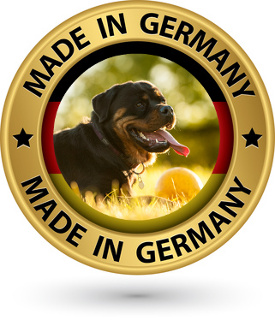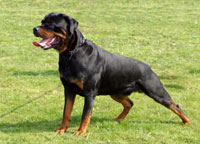
In This Article You Will Read About
“I want a German Rottweiler. They’re better”
“Only German Rottweilers have those big heads!”
“German-bred Rotties are superior to the American ones.”
These sorts of comments can be heard every day, but are they true?
Well, there’s no simple answer to this, and my response would be both ‘Yes…….. and No’
If this makes you feel a bit confused, don’t worry – you’re not alone!
Rottweilers born and registered by the ADRK in Germany are the ‘cream of the crop’, and are the only TRUE ‘German Rottweilers’, but this is often where the confusion begins.
Read on to find out why German-born Rottweilers are usually superior to Rottweilers born anywhere else….. and to learn more about that tricky German v American Rottweiler question.
What Makes A German Rottweiler….. German?

So, what is a German Rottweiler? In order to be considered German, a German Rottweiler has to be born in Germany, or have parents who are German-born with ADRK (Allgemeiner Deutscher Rottweiler Klub) registration papers.
But of course, it’s not always as easy as that – and this is just the beginning of the story.
Given the above statement, then all other Rottweilers born across the world are also ‘citizens’ of their country of birth….
… but this doesn’t explain why German Rottweilers are considered to be superior.
To fully understand that part, consider a puppy’s pedigree as the document that determines the quality of that puppy.
A pedigree shows a puppy’s bloodlines (or ancestors) – think of it as your pup’s ‘Family Tree’.
The quality of the dogs in your puppy’s pedigree directly affects the quality of your pup, both in terms of looks (‘conformation’), temperament, and health. THIS is where the superior quality of German Rottweilers is found.
It’s also where some of the confusion over German v American Rottweilers is often found. Let’s put it this way…..
If your puppy was born in New York, for example, he is by definition an American Rottweiler (by birth). But that isn’t what determines the size of his head, the quality of his hips, or the type of temperament he has. His bloodlines do that.
If his Sire and Dam are German-born and ADRK registered, the chances of your puppy being an excellent representative of the breed are very high – regardless of which country he was born in.
But why is a German Rottweiler so much better than an American (or British, Belgian, Australian etc.) Rottweiler?
Why is having German-born dogs in your pup’s pedigree so important?
The answer to that lies with the ADRK in Germany.
The ADRK is basically the German breed club for the Rottweiler (the ‘parent breed club’ you could say), and its main goal is to protect the Rottweiler breed.
What do I mean by ‘protect the Rottweiler breed’? Well, the original slogan of the ADRK was
‘Rottweiler breeding is, and remains, the breeding of working dogs’
This is still a very important point today.
Always remember that although your little guy or girl may be destined for a life of luxury, as a much-loved family companion, the Rottweiler is a working breed.
Rottweilers shouldn’t just look like Rottweilers, they should act and move like Rottweilers too, and have the ability to perform the tasks/duties that the breed was originally designed for.
Defining German Rottweilers
Today the ADRK has a long list of aims, which you can read on the official ADRK website.

But I think it’s simpler to sum up this organization’s aims like this…
‘The ADRK defines and promotes the Rottweiler Breed Standard and enforces these standards through strict breeding protocols’.
This is the foundation for the superior quality of German-born Rottweilers.
No litter of Rottweiler puppies can be registered in Germany unless the Sire and Dam have passed the very strict ZTP (Breed Suitability Test).
This consists of a set of comprehensive conformation, temperament, and health evaluations which are in place to ensure that only the best representatives of the breed are allowed to produce puppies.
The ZTP places emphasis on both conformation (size, head, coat, eye color, teeth, no disqualifying faults as per show-ring, etc.), and temperament (obedience, courage, attentiveness, hardness, and more).
Other factors are also included, such as the dog’s age (must be at least 18 months old), hip classification (must have an HD- or HD+/- equivalent to OFA excellent and OFA good ratings), and have passed at least a basic BH Degree (similar to AKC’s CD or Companion Dog qualification).
Many other European countries don’t have the same rigorous standards, so even if a puppy is European born it doesn’t necessarily mean that it will be close to the quality of a German Rottweiler puppy.
In the USA, the United States Rottweiler Club (or USRC) has a similar test that its member’s dogs need to conform to.
It’s called the BST or Breed Suitability Test. You can find out more about this club at www.usrconline.org
Other countries follow the lead of the ADRK very closely, and although the Breed Standard for the Rottweiler dog varies slightly from country to country.
Any puppy that results from a properly thought out and implemented breeding program will be clearly recognizable as a Rottweiler.
Difference Between the German Breed Standard and the US Breed Standard
There is at this point (August 2014) is one big difference between the German breed standard and the US breed standard though.

Credit @vonruelmann_rottweilers

Credit @diesel.rott
That is the fact that in Germany a Rottweiler’s tail is now left natural, while the AKC Breed Standard (USA) requires the tail to be docked (cut short).
These regulations will change at some time in the future and dogs here will also be required to have natural tails.
As it is, US breeders who closely follow the FCI Code of Ethics, and who show their dogs in German-style ‘Sieger’ competitions here, are beginning to leave their pup’s tails un-docked.
If you aren’t looking for a pup to enter in AKC shows, then personally I don’t think there’s any reason to choose a pup with a docked tail over one who has a full tail.
German Rottweiler vs American Rottweiler
We have established that a major difference between the two Rotties is the fact that German Rotties are born in Germany while American Rotties are born in America. Are there any other differences between the two animals?
Yes, there are, although these differences are not so significant. They include:
Tail: German Rotties have natural tails as opposed to American Rotties that tend to have docked tails.
Size: German Rotties are larger in size than their American siblings, although not by a wide margin. The animals have broader bodies than the American Rotties, although they also have legs that are slightly shorter than those of the American Rottie. Therefore, German Rotties, while a little shorter than their American counterparts, are also broader and stockier than them.
Head size: The German Rottie has a larger and broader skull than that of the American Rottie, meaning that its head is larger than that of the American Rottie.
How About similarities?
With the exception of the differences stated above, both Rotties are similar in every other respect.
Coat coloring: Regardless of whether the animal is a German Rottie or an American Rottie, the coloring is always the same black with bronze markings.
Eye color: The eye color of both Rottweilers is dark brown, and the eyes are almond-shaped.
Which One Is Better for Me – the German Rottweiler or the American Rottweiler?
Both breeds of Rottweilers are great animals in their own rights. It all boils down to what you really want in a dog and how much you have to spare in getting the dog.
Since German Rotties are purebreds with a superior lineage to that of the American Rotties, you can expect to pay more for them than you would for American Rotties.
When getting a Rottweiler, whether an American or German one, it is always best to get one that has been bred according to the standard for this breed as they are usually healthier. This is why it is always emphasized that you buy dogs from reputable breeders.
Unethical breeders might try to sell off Rottweilers that are not purebred to you by lying and claiming that they are purebred but rare colored. These breeders might even want to sell these “rare colored” Rotties at very exorbitant prices.
You should be careful not to fall victim to these people, as you will only end up spending unnecessary money, both in buying the dog and in taking care of a pet that keeps having health issues. This is because non-purebred Rotties usually have more health challenges than purebred ones.
However, aside from the minor differences mentioned above, both dogs are almost the same in looks and temperaments, although poor breeding practices in the American Rottweiler may actually make their German counterparts preferable.
Other types of Rottweilers
Serbian Rottweilers

Credit @vonnbela_rottweilers
Serbian Rottweilers are Rotties whose lineage can be traced to Serbia, in the same way that German Rottweilers have ancestors that originate from Germany. In terms of looks, these dogs are even more stocky and bigger in appearance than the German and American Rottweilers.
Serbian Rotties are also reputed to have larger heads than both the German and American Rotties. Like the German Rotties, Serbian Rotties have tails.
European Rottweilers
These are Rottweilers that are born and bred in Europe or have parents who are born and bred in Europe.

Credit @vonruelmann_rottweilers
To Sum It All Up…..
A true German Rottweiler is one born in Germany.
German-born Rottweilers have to adhere to strict protocols when being bred, and consequently generally produce pups that are superior in conformation, temperament and health than elsewhere.
Rottweilers born in other countries can be of the same quality if they have excellent German bloodlines in their pedigree (including close relatives though, not just 4 or 5 generations back).
But they are not German Rottweilers, they’re ‘citizens’ of their country of birth, but with German ancestry.

